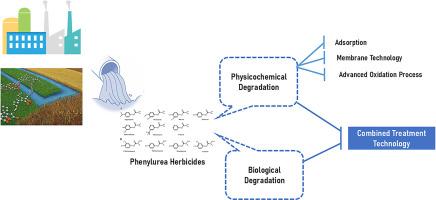了解苯基脲类除草剂的环境归宿和清除策略:全面回顾
IF 5.4
Q2 ENGINEERING, ENVIRONMENTAL
引用次数: 0
摘要
长期以来,苯基脲类除草剂因其控制杂草的功效而被广泛应用于农业实践中。它们在现代农业中发挥着重要作用,有助于保护作物。然而,它们的广泛使用引起了人们对其环境归宿和对生态系统潜在不利影响的担忧,从而促使人们对其归宿和清除策略进行广泛研究。本综述探讨了苯基脲类除草剂的环境归宿,重点关注其持久性、流动性和生物利用率。此外,还分析了苯脲类除草剂存在的生态后果,例如对非目标生物的影响和生物累积潜力。综述还深入分析了包括物理、化学和生物方法在内的清除策略,强调了这些方法的有效性和局限性。本研究深入探讨了从环境基质中去除苯基脲类除草剂的成功应用和遇到的挑战。本综述是研究人员、政策制定者和环境从业人员全面了解苯脲类除草剂和应对相关环境风险的宝贵资源,可指导人们在保护环境质量和生物多样性的同时,安全有效地使用苯脲类除草剂。本文章由计算机程序翻译,如有差异,请以英文原文为准。

Understanding the environmental fate and removal strategies of phenylurea herbicides: A comprehensive review
Phenylurea herbicides have long been utilized in agricultural practices for their efficacy in weed control. They play a significant role in modern agriculture, aiding in crop protection. However, their extensive use raises concerns about their environmental fate and potential adverse impacts on ecosystems thus prompting extensive research into their fate and removal strategies. This comprehensive review explores the environmental fate of phenylurea herbicides, focusing on their persistence, mobility, and bioavailability. Furthermore, the ecological consequences of their presence, such as effects on non-target organisms and potential for bioaccumulation, have also been analysed. The review also provides an in-depth analysis of removal strategies, encompassing physical, chemical, and biological methods, highlighting their effectiveness and limitations. The present study offers insights into successful applications and challenges encountered in removing phenylurea herbicides from environmental matrices. This review serves as a valuable resource for researchers, policymakers, and environmental practitioners seeking a comprehensive understanding of phenylurea herbicides' and addressing the environmental risks associated with them, guiding efforts toward their safe and effective use while preserving environmental quality and biodiversity.
求助全文
通过发布文献求助,成功后即可免费获取论文全文。
去求助
来源期刊

Journal of hazardous materials advances
Environmental Engineering
CiteScore
4.80
自引率
0.00%
发文量
0
审稿时长
50 days
 求助内容:
求助内容: 应助结果提醒方式:
应助结果提醒方式:


